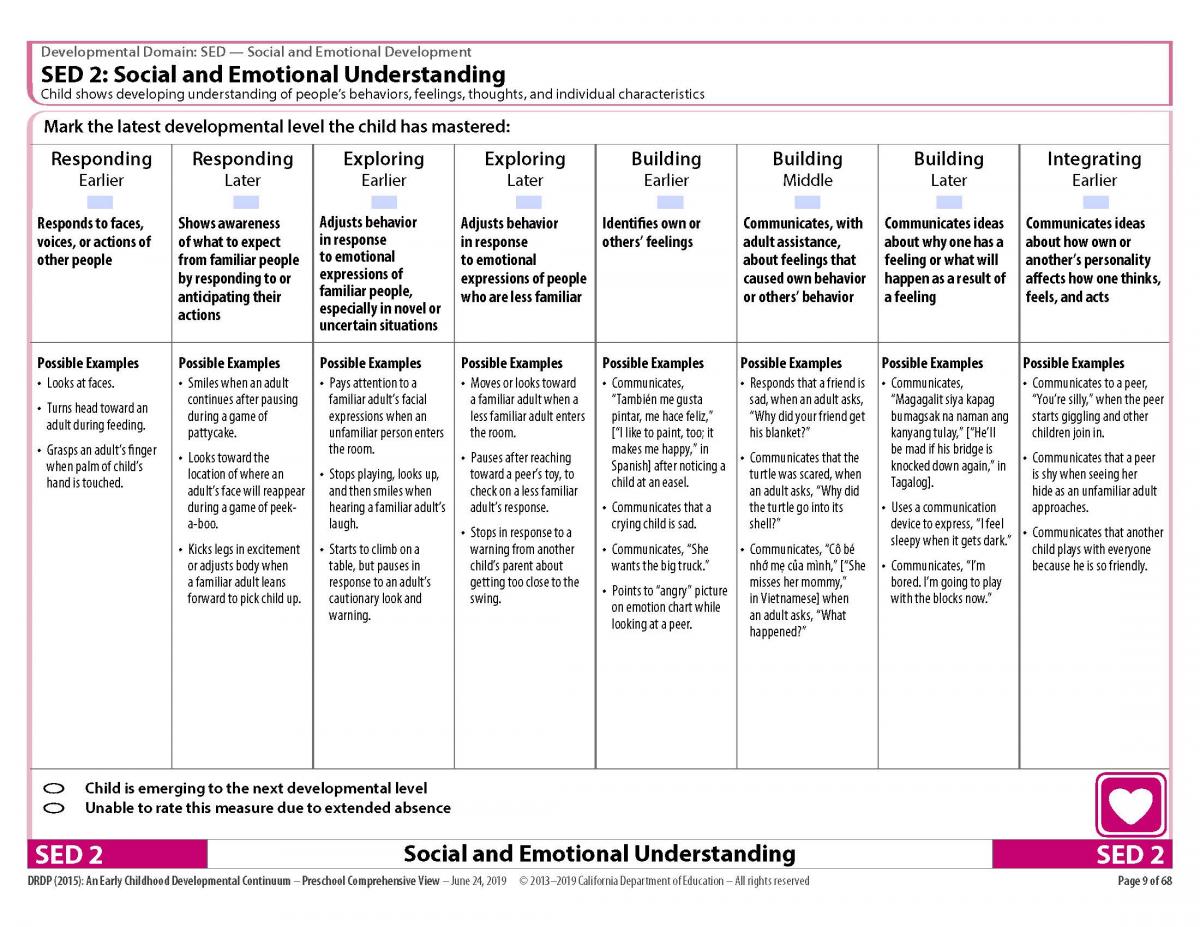Return to DRDP Measure Video Examples
Definition: Child shows developing understanding of people’s behaviors, feelings, thoughts, and individual characteristics
 View examples of the developmental levels for SED Measure 2 below: Responding Earlier, Responding Later, Exploring Earlier, Exploring Later, Building Earlier, Building Middle, Building Later, Integrating Earlier
View examples of the developmental levels for SED Measure 2 below: Responding Earlier, Responding Later, Exploring Earlier, Exploring Later, Building Earlier, Building Middle, Building Later, Integrating Earlier
Note: For young children, learning is an integrated experience. The examples below may include multiple areas of learning and development.
Responding EarlierResponds to faces, voices, or actions of other people Possible Examples - Looks at faces.
- Turns head toward an adult during feeding.
- Grasps an adult’s finger when palm of child’s hand is touched.
| |
Responding LaterShows awareness of what to expect from familiar people by responding to or anticipating their actions Possible Examples - Smiles when an adult continues after pausing during a game of pattycake.
- Looks toward the location of where an adult’s face will reappear during a game of peek-a-boo.
- Kicks legs in excitement or adjusts body when a familiar adult leans forward to pick child up.
| Source: California Department of Social Services. 2016. |
Exploring EarlierAdjusts behavior in response to emotional expressions of familiar people, especially in novel or uncertain situations Possible Examples - Pays attention to a familiar adult’s facial expressions when an unfamiliar person enters the room.
- Stops playing, looks up, and then smiles when hearing a familiar adult’s laugh.
- Starts to climb on a table, but pauses in response to an adult’s cautionary look and warning.
| |
Exploring LaterAdjusts behavior in response to emotional expressions of people who are less familiar
Possible Examples
- Moves or looks toward a familiar adult when a less familiar adult enters the room.
- Pauses after reaching toward a peer’s toy, to check on a less familiar adult’s response.
- Stops in response to a warning from another child’s parent about getting too close to the swing.
| |
Building EarlierIdentifies own or others’ feelings Possible Examples - Communicates, “También me gusta pintar, me hace feliz,” [“I like to paint, too; it makes me happy,” in Spanish] after noticing a child at an easel.
- Communicates that a crying child is sad.
- Communicates, “She wants the big truck.”
- Points to “angry” picture on emotion chart while looking at a peer.
| |
Building MiddleCommunicates, with adult assistance, about feelings that caused own behavior or others’ behavior Possible Examples - Responds that a friend is sad, when an adult asks, “Why did your friend get his blanket?”
- Communicates that the turtle was scared, when an adult asks, “Why did the turtle go into its shell?”
- Communicates, “Cô bé nhớ mẹ của mình,” [“She misses her mommy,” in Vietnamese] when an adult asks, “What happened?”
| |
Building LaterCommunicates ideas about why one has a feeling or what will happen as a result of a feeling Possible Examples - Communicates, “Magagalit siya kapag bumagsak na naman ang kanyang tulay,” [“He’ll be mad if his bridge is knocked down again,” in Tagalog].
- Uses a communication device to express, “I feel sleepy when it gets dark.”
- Communicates, “I’m bored. I’m going to play with the blocks now.”
| |
Integrating EarlierCommunicates ideas about how own or another’s personality affects how one thinks, feels, and acts - Communicates to a peer, “You’re silly,” when the peer starts giggling and other children join in.
- Communicates that a peer is shy when seeing her hide as an unfamiliar adult approaches.
- Communicates that another child plays with everyone because he is so friendly.
| What would your example be? |
Return to DRDP Measure Video Examples
 View examples of the developmental levels for SED Measure 2 below: Responding Earlier, Responding Later, Exploring Earlier, Exploring Later, Building Earlier, Building Middle, Building Later, Integrating Earlier
View examples of the developmental levels for SED Measure 2 below: Responding Earlier, Responding Later, Exploring Earlier, Exploring Later, Building Earlier, Building Middle, Building Later, Integrating Earlier